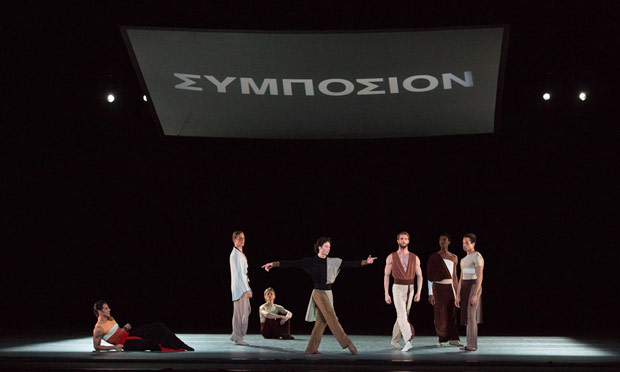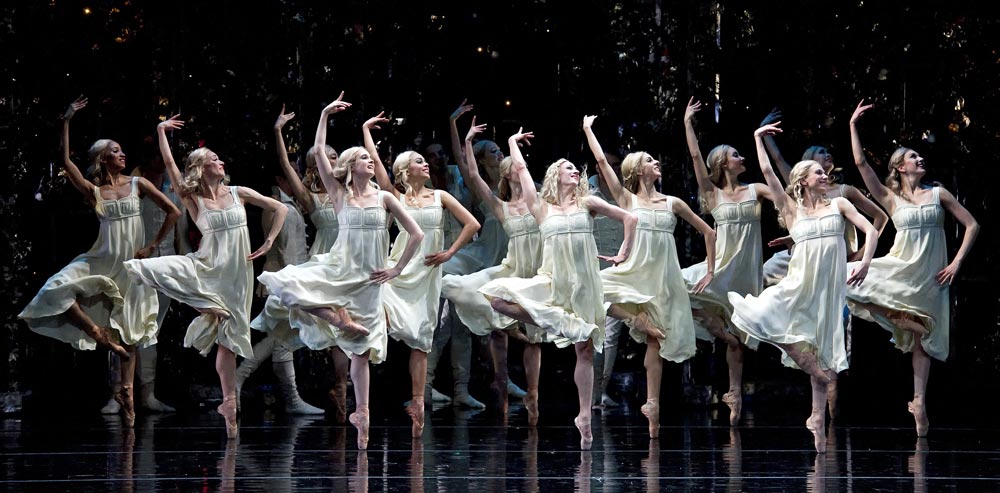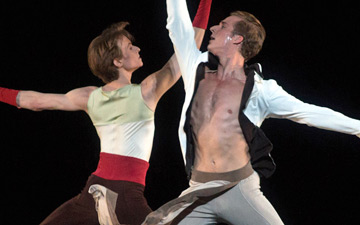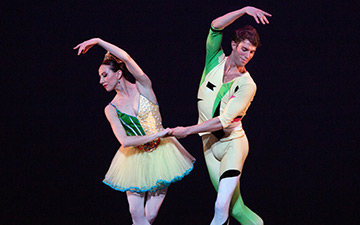
© Rosalie O’Connor. (Click image for larger version)
American Ballet Theatre
Spring Gala: Excerpts from Sylvia, The Sleeping Beauty, La Fille Mal Gardée, and Requiem; Serenade after Plato’s Symposium, Firebird
★★★★✰
New York, Metropolitan Opera House
17 May 2016
www.abt.org
In with the New
After a run of performances of Frederick Ashton’s mythological ballet Sylvia, American Ballet Theater launched into its week-long Ratmansky festival with a gala that included a new ballet (Serenade after Plato’s Symposium) and the first performance of his Firebird since 2012. There were various excerpts too, the most promising of which was the ribbon duet from the first act of Frederick Ashton’s La Fille mal Gardée, danced by Isabella Boylston and Jeffrey Cirio. (That ballet begins its run next Tuesday.)
It isn’t often that a gala program proves satisfying, but this one was the exception. The new Serenade after Plato’s Symposium and Firebird are both important works, in vastly different styles. They prove that Ratmansky is the most wide-ranging ballet choreographer working today. This season includes eight of his ballets, everything from his hyper-classical Sleeping Beauty (based on early twentieth century notations) to his folk-inflected staging of Rimsky-Korsakov’s Golden Cockerel and the Soviet-influenced Shostakovich Trilogy. Firebird is in its own category, a fantastical reinterpretation of the ballet originally created by Igor Stravinsky and Michel Fokine for Diaghilev’s Ballets Russes. Ratmansky more or less follows the story, but sets it in a dream-like swamp of gnarled, smoke-emitting tree-trunks populated by gothic villains and goblin-like princesses. (The sets are by Simon Pastukh.)
In the new ballet, Serenade after Plato’s Symposium, Ratmansky once again enters new choreographic terrain. Set to Leonard Bernstein’s five-movement violin concerto of the same name, the ballet for seven men and one woman is a kind of danced conversation. (Both the music and the ballet are inspired by Plato’s Symposium, which includes seven dialogues on the subject of love.) Here, the dancers “speak” with their hands and bodies, to each other and to us. Some of the dances are soliloquies, others are dialogues. As the ballet begins, a central figure – Herman Cornejo – articulates complex phrases with his arms and hands as the other men listen and eventually join in, lifting, supporting, partnering him. Men recline in various poses, others come and go. They are almost never all onstage at once.
The soft, flowing, Greek-inspired costumes are by Jérôme Kaplan, with whom Ratmansky has worked before on his Lost Illusions and Don Quixote. The stage design is simple and effective: a white banner that reads “symposium” in Greek rises and tilts, affecting the light and the mood. The earthy, color-block costumes are elegant and flatter the body. Each has a different neckline and pattern. They move pleasingly with the dancing, adding fluidity and weight to the steps, like the jersey costumes in Twyla Tharp’s Sweet Fields. There’s something very American about the whole piece, a relaxed, lilting dynamic reminiscent of Mark Morris that later morphs, with the music into a more upbeat jazziness in the style of Jerome Robbins. I think I spotted a little quote from the Robbins-Bernstein collaboration Fancy Free, a cheeky salute by James Whiteside in the middle of a syncopated phrase.

© Rosalie O’Connor. (Click image for larger version)
The cast looks fantastic; Ratmansky has a knack for figuring out how to get the best out of each dancer, and then push him (or her) to do just a little bit more. Cornejo’s quiet authority and extraordinary musicality lie at the ballet’s heart. All the men relate to him at one time or another. At one point he flies backward in a series of skittering steps and hops that seem to barely skim the stage. At another, he opens his arms tautly, then crosses his wrists in front of him, like a bharata natyam dancer. Each dancer gets his moment: Daniil Simkin does a broad and funny drunk dance – in Plato’s Symposium, Alcibiades turns up soused – and then launches into a series of driving jumps that have him soaring through the air like an arrow, to much applause. Blaine Hoven shimmies and shakes his shoulders in a loose, Tharpian style. Calvin Royal III dances a long, supple, legato solo in which he never looks out at the audience, as if lost in thought. Eventually he is surrounded by the other men, who hold their arms out, like wings. They look like moths surrounding a flame. He collapses, they lift him up. Amongst other things, the ballet is a moving depiction of friendship and support.
Devon Teuscher, the lone woman, may be a stand-in for the priestess Diotima, who also figures in the Symposium. Teuscher appears out of a crack in the darkness during Bernstein’s dramatic final movement, illuminated by an orange background and wearing a stunning turquoise chiton-like dress. She dances an impassioned pas de deux with Marcelo Gomes, full of sculptural lifts and deep lunges. Her expression is grave; she seems determined to tell him something, or perhaps to draw him away from the other men. In the ballet’s closing image, she reappears; the men all reach toward her, and then the light goes out. It will take further viewings to fully understand her role – I don’t quite get the ending – but the good news is that this is a ballet to come back to again and again. Bernstein’s music is enigmatic, searching, and surprisingly dance-friendly. The violin soloist, Benjamin Bowman, played with a haunting sweetness. The choreography is both rich and essential. Like the book upon which it is based, it has much to say.
I’ve written about Ratmansky’s Firebird before, so I won’t go on, but I will say this: it looks better now than it did four years ago. Much of it would not be out of place in a movie musical, and at times it could be a post-apocalyptic version of The Wizard of Oz. These are not criticisms, but a recognition of the ballet’s wonderful strangeness. Maybe the company has grown into his style. The acting, throughout, was vivid and sharply-etched. Cory Stearns, handsome and tall, makes an excellent villain; he seems to relish blowing smoke out of his mouth, tiptoeing across the stage at a tilt, and twiddling his fingers like a mad hatter. Stella Abrera was a natural as the dopey, troll-like princess, her dancing full of fussy little head-shakes and chugging arms. The Firebird, danced by Misty Copeland, is a truly untamable creature, her back arched way from the young prince who struggles to capture her. Though she doesn’t have the elevation or attack Natalia Osipova had in the ballet’s first season, there is a sly sinuousness to Copeland’s interpretation that makes it perhaps more captivating. And Gomes, as the prince, is his usual self: gallant, generous, quietly noble.

Other bits and pieces filled out the gala program: the Vision Scene from Sleeping Beauty, the entrance of the huntresses in Frederick Ashton’s Sylvia, and a very quiet, very spare solo from Kenneth MacMillan’s 1978 Requiem, danced by Alessanra Ferri dressed all in white. (The “Pie Jesu” from Fauré’s Requiem was beautifully sung by the soprano Ying Fang.) The solo, which consists mostly of walking and quick rises onto pointe, shows off Ferri’s considerable charisma, her big soulful eyes, her long, mournful arms and slight figure. There’s no doubt she can hold a stage; later in the season, nearly a decade after her farewell, she will dance a single performance of Romeo and Juliet.
But this is a season to relish the new. The company will perform Serenade after Plato’s Symposium several more times this week, as well as Seven Sonatas (from 2009), Firebird, and the Shostakovich Trilogy (2013). Later in the season it will be time for The Golden Cockerel (2012) and Ratmansky’s reanimation of the spirit of Petipa, Sleeping Beauty. There’s a lot to look forward to.

















You must be logged in to post a comment.